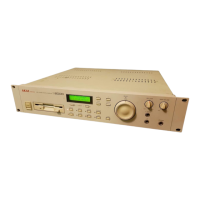PROGRAM EDIT
S2000 Operator’s Manual - Version 1.30 Page 69
OVERLAPPING AND CROSSFADING KEYGROUPS
So far we have seen keygroups side by side. This is usually fine for most applications but there
are sometimes occasions where the abrupt transition between one keygroup and another can
be a bit obvious. For example, in a strings program where you have five string samples each at
the G of every octave, the transition between B2 and C3 may sound a little strange.
The reason for this will normally be that the G2 sample is transposed up by four semitones at
B2 and so sounds a little brighter whilst the G3 sample is being played 7 semitones down so it
may sound a little duller and so, next to each other, especially when playing a scale, the
crossover point is not even.
To overcome this, we can overlap keygroups simply by setting their key ranges accordingly:
It may be, however, that this does still not overcome the problem and so there is a facility to
crossfade keygroups for an even smoother transition where one keygroup gradually fades
down through the overlap whilst the other fades up thereby giving a smooth transition. I.e:
Of course, you can use a combination of any of the above techniques and have crossfading,
velocity switched keygroups in programs alongside layered and split keyboard assignments.
The above diagram examples represent only part of the flexible program editing and multi-
sampling potential of the S2000.
If all this seems very confusing, don’t worry for the moment. There are many easy routines in
EDIT PROG that allow you to edit all keygroups simultaneously or to copy keygroups and within
a short time, you will be making programs very quickly and easily.
If you have already owned an Akai sampler, then you will probably be familiar with a lot of what
we have just seen but, if this is your first time with an Akai sampler, it is worth taking the time to
get a fairly good understanding of these principles and the concept of keygroups if you are
going to get the best out your sampler.

